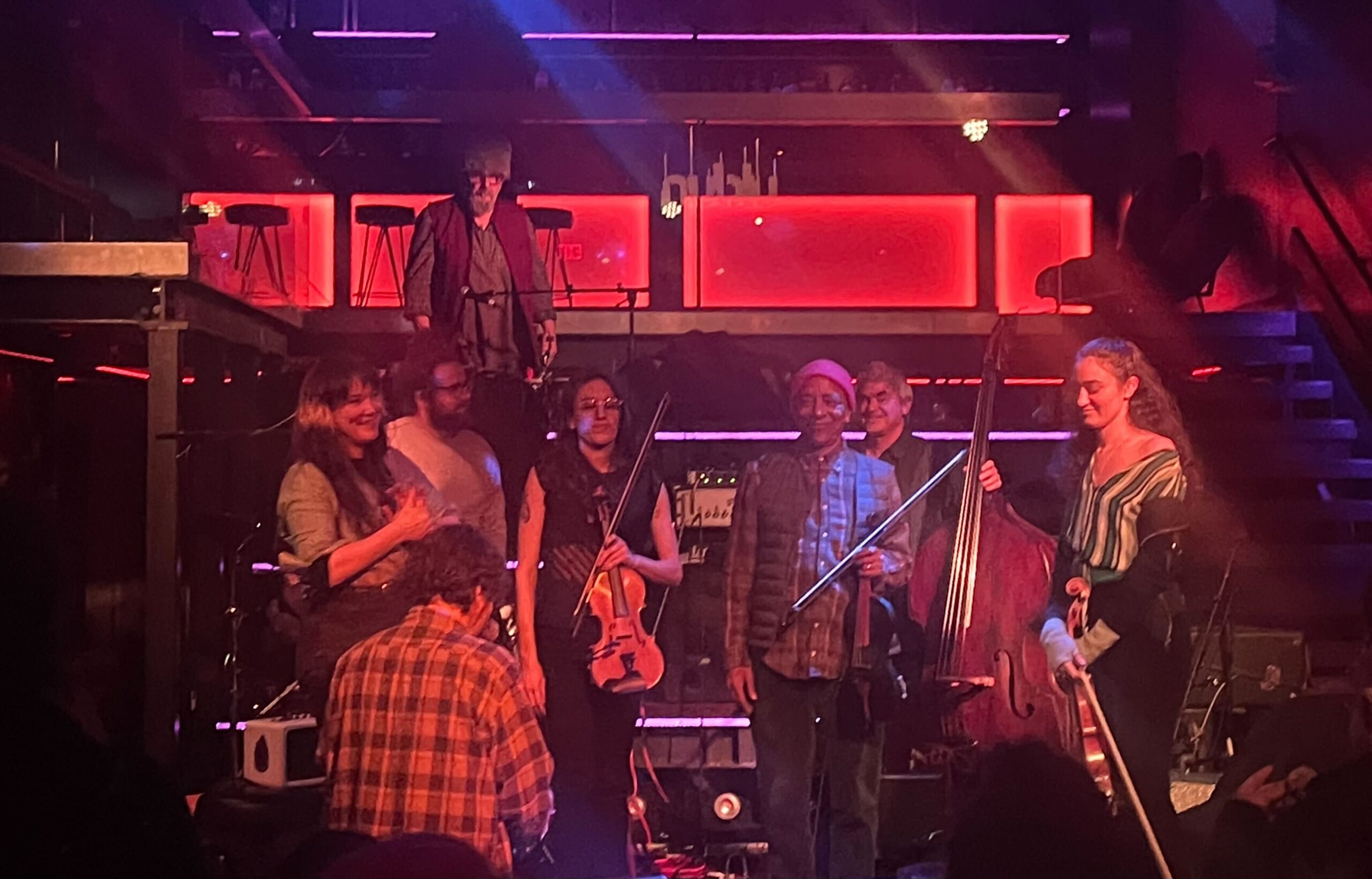On a cold and rainy night, through an unassuming door on the corner of 9th St. and Avenue C, nine of New York City’s most talented experimental musicians crammed themselves onto a small stage amid the backlit steps of the Nublu jazz club to deliver two hours of improvised magic. The Operatic Orchestra, featuring guitar player Wendy Eisenberg, soprano vocalist Ju-Eh, violinists Charlie Burnham and Gabby Fluke-Mogul, viola player Joanna Mattrey, percussionist Cyro Baptista, bassist Tony Garnier, and drummer Asher Herzog was assembled by conductor Billy Martin and presented by the Creative Music Studio.
The Creative Music Foundation, a non-profit organization, was formed in the early ‘70s by Karl Berger, Ingrid Sertso, and Ornette Colemam. Focused on teaching and uniting experimental and improvisational musicians from different backgrounds, the Creative Music Studio has served as the group’s primary program since its inception. As President and CEO Martin put it, “it’s not about style and it’s not about genre, it’s just about making music with everybody.”
The showcase featuring the Operatic Orchestra, gathered for only two sets at Nublu on December 8th, while a second performance featuring a slightly different lineup took place in Saugerties, New York, on December 11th.
The performers come from vastly different musical backgrounds. Martin, who teaches at The New School, is best known as one-third of experimental music trio Medeski, Martin & Wood. Charlie Burnham and Cyro Baptista have long and storied careers as session musicians, Wendy Eisenberg (my guitar teacher at TNS!) just released a banjo record called “Bent Ring,” among their myriad of projects, and Asher Herzog is a current student at, you guessed it, The New School. Despite working in such different capacities, the musicians find common ground in improvised music, providing for a unique collaboration.
Each performer came to find experimental music through contrasting outlets. “It started in the ‘80s when I got into Brazilian and Pan-African music,” Martin explained. He recalled how he “met a lot of jazz musicians in New York through that – Bob Moses, Jaco Pastorius, Pat Metheny, John Scofield, Bill Frisell, they were all these older dudes that I was playing with…and it sort of rubbed off on me, this open way of playing.”
“When Medeski, Martin & Wood formed,” Martin added, “we developed our own sound and I found my own voice. I love all kinds of music.”
Speaking to how they entered the field, guitarist Eisenberg commented, “when I was in jazz school, it didn’t feel totally right to be doing this thing that felt gate-kept, and super male. Also there was a super huge racial-politics thing…I thought, ‘how do I explore what I love about jazz from all angles and not just through an often white-supremacist lens,’ which led me to harsh noise, because it feels like jazz but isn’t. …Then I remembered I liked playing guitar and not pedals, so I got into improvising harsh noise, which turned into some hybrid of the two.”
But why and how did this particular group of musicians come together? “It’s sort of intuitive,” Martin said, “a lot of it is just watching and listening…just admiring other players and seeking them out.”
Listening is perhaps the driving force behind CMS and a lot of improvisational music. Martin explained: “Listening is the most important thing, it’s something I always stress when I teach and when I work at CMS… with everything in life you’re observing and that starts to inform you in a way.”
“Charlie Burnham is one of my favorite violinists in the world and Gabby is one of my best friends,” Eisenberg added, “Cyro Baptista with this band Ambitious Lovers… actually changed the trajectory of my life.”
Throughout the performance, the overall tonality of the music shifted in vastly divergent directions. Moments of great intensity, horrific beauty, and abhorrent disregard for conventionality, juxtaposed against bright, light-hearted and at times playful passages exuded from the players as the night progressed. Prior to the performance, no discussions about keys, changes, time signatures, chords, rhythms, polyrhythms, substitutions, moods, or objectives with regards to the music took place. “The only thing that we talked about approaching the performance was, ‘it’s going to feel like chamber music,’ and, ‘here are the hand gestures that mean the things that they mean,’” Eisenberg said.
“It starts with trust and admiration… and being down for anything,” Martin added, “they’re improvisers, and they’ll throw down.”
Martin describes his conduction style as “simple.” According to him, it can be taught in under 10 minutes during a soundcheck. “Sometimes it’s intuitive conducting, calling out players to play, other times there’s a system… I call it ‘point-ill-ism,’” Martin said. “It’s my own name for this conducting technique that gives the players an opportunity to create their own rhythmic pulse and choose their own note or sound, and then I can sort of switch their pulse by giving them a signal, they have to watch and follow me, but they still have their own control and choice as to the subtleties that are going on.”
Even under the guidance of a conductor, the sounds heard in Nublu could not have been predicted by Martin, or anyone. “There’s no knowing what’s going to happen or planning it,” Martin said. “You have to be open to taking it in different directions, but really it’s up to the musicians to collectively make it go there. No one controls the thing, we have to work together collectively, as an organism.”
Stay up to date with Creative Music Studio here: https://creativemusic.org/
I play, I write, I play, I write…







